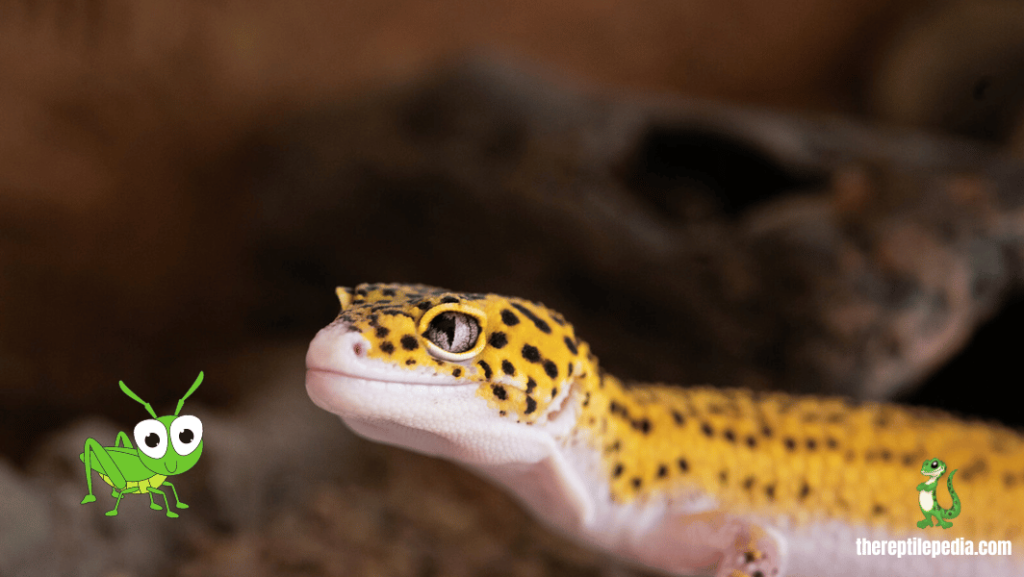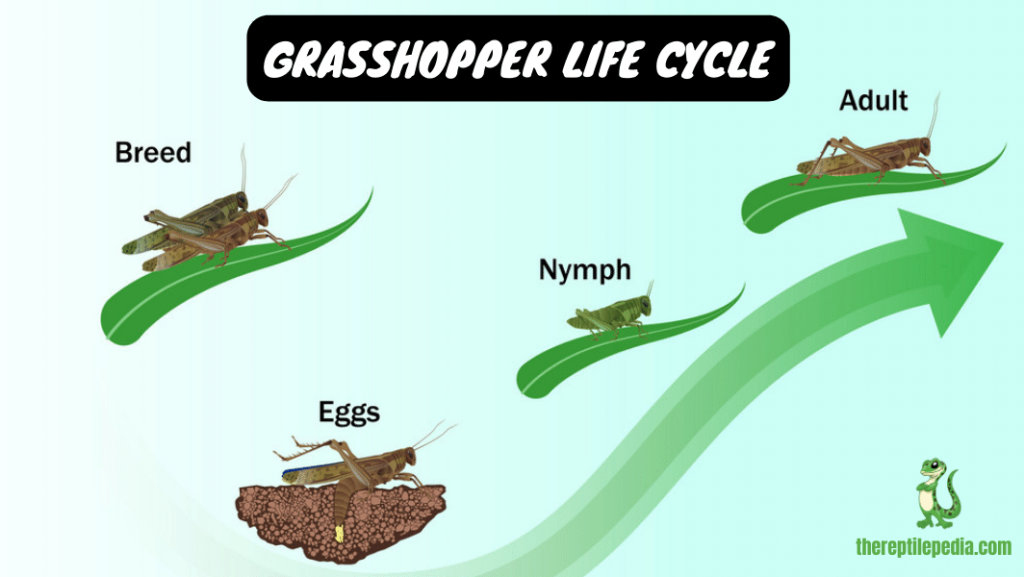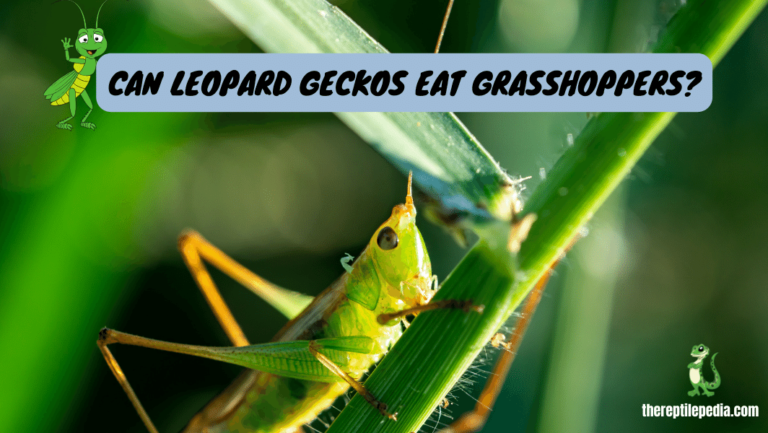In the diverse world of pet care, the question of whether Leopard Geckos can safely eat grasshoppers is quite common. These reptiles, scientifically known as Eublepharis macularius, thrive on a varied diet that includes a range of insects, making grasshoppers an exciting addition. From personal experience, I’ve found that incorporating grasshoppers, specifically Acrididae spp., into their meals not only boosts their nutrient intake with high protein and an approximate Ca:P ratio but also offers environmental enrichment by practicing hunting. It’s crucial, however, to ensure these grasshoppers are not toxic or poisonous and are bought from reputable sources, whether you opt for live feeder insects or freeze-dried options.
When feeding Leopard Geckos grasshoppers it’s important to start with smaller sizes to avoid any impaction risk, especially since they can grow large. This approach not only adheres to good husbandry practices by providing a varied and nutrient-rich diet but also stimulates their natural hunting instincts, making mealtime more engaging. Always quick to learn, these geckos will find and eat the right grasshoppers with enthusiasm, making it a rewarding experience for both the pet and the owner.
Table of Contents
Leopard Geckos Can Eat Grasshoppers
Feeding Grasshoppers to Leopard Geckos can be a safe and nutritious option, but it’s crucial to pick the right species to avoid any toxic or poisonous risks. While locusts, a type of grasshopper, are often seen in swarms and can be easy to catch, not all are suitable for feeding to your pet. There are drawbacks and challenges to consider, such as ensuring the grasshoppers haven’t been exposed to pesticides. Being aware of these risks will help you provide a healthy diet for your gecko without any adverse effects.
Are Grasshoppers Good and Healthy for Leopard Geckos?
Grasshoppers into your Leopard Gecko’s diet can be a smart choice, as they are a good source of protein, calcium, vitamins, and trace minerals like iron, zinc, copper, and magnesium. These nutrients are vital for maintaining a healthy reptile, with the added high fiber content of grasshoppers being particularly beneficial for your pet’s digestive system. However, it’s important to balance this with other foods and animal products to ensure a varied diet. Feeding grasshoppers to your leopard gecko too much at once can lead to overfeeding and potential obesity, so it’s crucial to weigh the pros and cons.
Keeping the intestines of your leopard gecko healthy is key, and while grasshoppers can provide many essential nutrients, moderation is essential. Offering a mix of suitable foods alongside grasshoppers will provide a balanced diet. Be mindful of the beneficial aspects of including grasshoppers in their diet but also be aware of the risks associated with overfeeding.
Pros Of Feeding Leopard Geckos Grasshoppers

- Grasshoppers are a nutrient-rich source of food for Leopard Geckos, offering a balanced blend of protein, calcium, and essential vitamins.
- They add variety to the diet, breaking the monotony of crickets and mealworms, and help in maintaining a healthy nutritional profile.
- The moisture and dietary fiber in grasshoppers aid in hydration and digestion, contributing to a high-fiber diet that prevents digestive problems.
- Introducing grasshoppers helps manage dietary excess, maintaining an optimal calcium to phosphate ratio crucial for preventing metabolic bone disease.
- Feeding live grasshoppers encourages natural hunting behaviors, providing both physical and mental enrichment.
- The energetic nature of grasshoppers, with their powerful hind legs, makes them an exciting challenge to catch, keeping your gecko active.
- This form of environmental enrichment prevents boredom, lethargy, and obesity in geckos, promoting a stimulating life in captivity.
- Grasshoppers offer a more natural and enriching dietary option compared to pre-made food mixes or dead insects.
- The active engagement required to catch grasshoppers fosters mental stimulation and physical health, enhancing overall animal husbandry.
By incorporating grasshoppers into their meals, you provide your Leopard Gecko with not just food, but an exciting, stimulating experience that mirrors their natural behaviors and contributes to their well-being.
ALSO READ: Can Geckos Eat Chicken?
Cons Of Feeding Leopard Geckos Grasshoppers
- While Grasshoppers can be a part of the diet, their high fat and low protein content compared to other staples make them less beneficial, potentially leading to obesity and other health problems in Leopard Geckos.
- The chitin in grasshopper exoskeletons can cause blockages in the digestive tract if consumed in large amounts, necessitating feeding them only sparingly.
- A diet overly reliant on grasshoppers might lead to calcium deficiency, a significant concern for the health and well-being of leopard geckos over an extended period.
- Although grasshoppers can add variety, they should not become the staple of the diet, highlighting the importance of a balanced approach to nutrition and feeding practices.
What Size Grasshopper Is Right For Leopard Geckos?
Choosing the right size grasshopper for your Leopard Gecko is crucial for their health and well-being. A good rule of thumb when feeding is to select insects that are smaller than the space between the gecko’s eyes, which is roughly the width of their throat. This helps prevent choking or impaction, as anything larger might be difficult for your pet to swallow. It’s important to observe your gecko eating; if they’re struggling to swallow, the insect might be too big. For adult geckos, large but not extra-large grasshoppers or locusts can be bought in various sizes from suppliers who often classify these insects to help you make the right choice based on your gecko’s age and size.
When in doubt about what type and size of grasshopper is best for your Leopard Gecko, seeking advice from your supplier can be very helpful. They can provide a guide to the most suitable sizes for different ages and stages of your gecko’s growth. Remember, not all grasshoppers and locusts are created equal; some may be too big, posing a risk to your pet. Making an informed choice ensures your Leopard Gecko can easily enjoy their meal without any struggle.
| Leopard Gecko Age/Size | Recommended Grasshopper Size |
| Hatchlings (0-2 months) | 1/4 inch to 1/2 inch |
| Juveniles (2-6 months) | 1/2 inch to 3/4 inch |
| Sub-Adults (6-12 months) | 3/4 inch to 1 inch |
| Adults (1 year and up) | 1 inch or larger |
Guidelines for Offering Grasshoppers to Your Leopard Gecko
To feed your leopard gecko grasshoppers, it’s essential to do so in moderation, ensuring they’re not the main diet but rather an addition that provides extra fiber and protein. Choose grasshoppers that are no bigger than the width of the gecko’s head to avoid choking or discomfort. The distance between the gecko’s eyes can be a helpful guide when deciding if the insects are too big or small. Following these parameters helps prevent any issues while offering a nutritious and safe meal to your pet.
How Many Grasshoppers To Feed To Leopard Geckos?
Determining how many grasshoppers to feed a Leopard Gecko depends on factors like its age, health status, and the size of the grasshopper. For a balanced diet, mix up the insects you offer, similar to how you might swap a cricket for a worm. A good rule is 5-8 correctly-sized insects per meal. For adult Leopard Geckos, this might mean feeding a few times per week, while baby Leopard Geckos need to eat daily due to their rapid growth. Always consider portion control, especially for babies, ensuring the insects are small and manageable to prevent any feeding issues.
| Leopard Gecko Age | Feeding Frequency | Number of Grasshoppers per Meal | Notes |
| Baby (0-4 months) | Daily | 5-10 | Small, appropriately sized grasshoppers; portion control is crucial. |
| Juvenile (4-12 months) | Every other day | 5-8 | Can introduce slightly larger insects; maintain a varied diet. |
| Adult (12+ months) | 2-3 times per week | 5-8 | Ensure grasshoppers are not larger than the space between the gecko’s eyes; variety is key. |
How Should You Prepare Grasshoppers To Feed To Leopard Geckos?
When preparing grasshoppers to feed to Leopard Geckos, it’s important to address their imbalanced calcium to phosphorus ratio, typically around 1:6, which can hinder getting enough calcium for your gecko. Without correction, your gecko’s body may leach calcium from its skeleton, leading to weak bones, seizures, or even death from metabolic bone disease. To correct this, gut load the feeder insects 24 hours before feeding them to your gecko, which enhances their nutritional value. Then, dust the grasshoppers with calcium powder right before feeding to ensure your gecko is getting enough calcium for a healthy diet.
Optimizing Grasshopper Nutrition for Leopard Geckos
Gut loading is a key step where you feed your grasshoppers nutrient-rich foods for at least 48 hours before feeding them to your Leopard Gecko. This ensures that when your gecko eats the insect, it also gains essential nutrients from the insect’s body. Suitable gut-loading foods include leafy greens, fruits like apples, and vegetables such as potatoes and squashes. Always ensure these foods are not toxic or unhealthy for the insects; for instance, avocado should be avoided.
For beneficial gut-loading, consider offering a specific food product designed for this purpose, like T-Rex® Calcium Plus Food, which is among the many options available. This helps to improve the calcium to phosphorus ratio in the insects. Additionally, providing a hydrated water source is crucial; use a bowl of water or a gel product like Fluker’s Cricket Quencher to prevent drowning, which is also fortified with calcium.

Before feeding the grasshoppers to your gecko, dust them with a calcium-rich powder such as Repashy Calcium Plus, highly recommended by herp vets. To dust insects thoroughly, place them in a plastic ziplock or sandwich bag with the powder and gently shake to ensure they are well-coated.
Baby, juvenile, sick, or gravid Leopard Geckos need dusted insects more frequently for their health. Healthy adults, however, may only require dusted insects once or twice a week to maintain their calcium levels without over-supplementation.
ALSO READ: Can leopard Geckos Eat Pinkies?
Other Food You Can Feed Your Leopard Gecko
Beyond grasshoppers, if you’re looking to feed your leopard gecko other food, you’ve got plenty of options. Mealworms are a favorite among reptile enthusiasts for their excellent source of protein and effortless care; with just a little effort in feeding and a handful of open container water to breed, they’re always ready to be added to your gecko’s enclosure.
On the other hand, Crickets offer great nutritional value and are easy to incorporate into your gecko’s diet, providing both food and an opportunity for them to indulge in their natural hunting instincts. Both these alternatives to grasshoppers ensure your leopard gecko has a varied and nutritious diet.
Nutrients in Grasshoppers
Grasshoppers are an excellent choice for your lizard’s diet, offering a nutritious option with minimal risk of health problems for your reptile pet. They are particularly high in calcium, which is essential, and you can enhance their nutritional value by sprinkling ground-up calcium on the food dish once or twice daily. A teaspoon per two ounces of food is a good measure. The real question many have is how to get their leopard gecko to eat these if they are not used to them. The trick is to remove other food items from the cage and present one or two insects right in front of your pet’s nose; they’ll likely grab it before you take it away.
For those who often come across freeze-dried grasshoppers, the answer to whether these can be fed is yes, but try freezing them first. They become limp, making them much easier for your gecko to eat. Make sure they are entirely thawed before offering them to ensure your gecko can easily digest them without any issues.
Are Grasshoppers Harmful to Leopard Geckos?
When considering if grasshoppers can potentially harm Leopard Geckos, it’s crucial to understand their herbivorous nature. Leopard Geckos are not naturally herbivores; they are insectivores and primarily eat live insects. While it’s true that grasshoppers are attracted to Leopard Geckos’ food, their powerful jaws are more accustomed to devouring raw vegetation than tiny geckos.
Although suppliers advise against using grasshoppers due to their biting tendencies, it’s not a significant issue if you promptly remove uneaten insects from the tank. In rare cases, a tiny bite from a grasshopper could potentially become infected and make your gecko unwell. However, with proper care and monitoring, the risk of harm from grasshoppers can be minimized.
Conclusion:
In the world of Leopard Geckos, knowing the answers to critical questions such as whether they can eat grasshoppers is essential for their health and nutrition. Staying informed about the latest news on their diet is important because any changes can affect their well-being. By understanding their dietary needs and being ready to adjust accordingly, you can ensure the best care for your Leopard Gecko.
FAQs:
-
Can leopard gecko eat flies?
Yes, leopard geckos can eat flies. Flies can be a part of their diet as they enjoy small insects. However, it’s essential to ensure the flies are appropriately sized and not contaminated with pesticides. Feeding a variety of insects is crucial for their nutritional needs, promoting their health and well-being.
-
What can leopard geckos eat besides crickets?
Leopard geckos can eat a variety of insects besides crickets, such as mealworms, Superworms, dubia roaches, and waxworms. Offering this diverse diet ensures they receive essential nutrients and prevents dietary boredom. Always provide appropriately sized and gut-loaded insects to maintain your gecko’s health and vitality.

